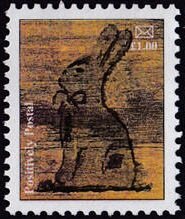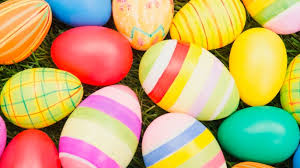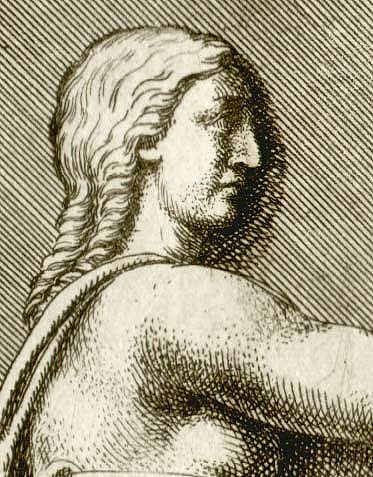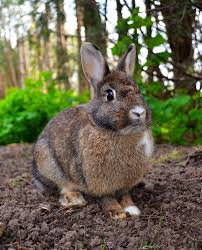Stamp: Easter - wood engravings (Cinderellas 2018)
Easter - wood engravings (Cinderellas 2018)
01 January (Cinderellas ) within release United Kingdom : Positively Postal goes into circulation Stamp Easter - wood engravings face value 1 British pound sterling
| Stamp Easter - wood engravings in catalogues | |
|---|---|
| Colnect codes: | Col: GB-PP 2018-04/2 |
Stamp is square format.
"Positively Postal" cinderella artistamp issued by Scott Thomson, an artist and stamp dealerAlso in the issue United Kingdom : Positively Postal:
- Stamp - Christmas face value 80;
- Stamp - Christmas face value 80;
- Stamp - Christmas face value 80;
- Stamp - Christmas face value 80;
- Stamp - Christmas face value 80;
- Se-tenant - Christmas face value 5*80;
- Stamp - Easter - wood engravings face value 1;
- Stamp - Easter - wood engravings face value 1;
- Stamp - Easter - wood engravings face value 1;
- Stamp - Easter - wood engravings face value 1;
- Stamp - Snail Mail face value 88;
- Stamp - Snail Mail face value 88;
- Stamp - Snail Mail face value 88;
- Stamp - Snail Mail face value 88;
- Stamp - St Andrew's Day face value 30;
- Stamp - St Andrew's Day face value 71;
- Stamp - St Andrew's Day face value 1.34;
- Stamp - St Andrew's Day face value 1.60;
- Stamp - Valentine's Day face value 55;
- Stamp - Valentine's Day face value 75;
- Stamp - Valentine's Day face value 1.05;
- Stamp - Valentine's Day face value 1.65;
- Stamp - Winter Olympics, PyeongChang: Bobsleigh face value 18;
- Stamp - Winter Olympics, PyeongChang: Luge face value 90;
- Stamp - Winter Olympics, PyeongChang: Skiing face value 1.12;
- Stamp - Winter Olympics, PyeongChang: Snowboarding face value 1.80;
- Stamp - Year of the Dog face value 18;
- Stamp - Year of the Dog face value 24;
- Stamp - Year of the Dog face value 90;
- Stamp - Year of the Dog face value 2.18;
|
Data entry completed
50%
|
|
|---|---|
| Stamp Easter - wood engravings in digits | |
| Country: | Cinderellas |
| Date: | 2018-01-01 |
| Emission: | Cinderella |
| Format: | Stamp |
| Face Value: | 1 British pound sterling |
Stamp Easter - wood engravings it reflects the thematic directions:
Easter, also called Pascha (Aramaic, Greek, Latin) or Resurrection Sunday, is a Christian festival and cultural holiday commemorating the resurrection of Jesus from the dead, described in the New Testament as having occurred on the third day of his burial following his crucifixion by the Romans at Calvary c. 30 AD. It is the culmination of the Passion of Jesus Christ, preceded by Lent (or Great Lent), a 40-day period of fasting, prayer, and penance.
Engraving is the practice of incising a design on a hard, usually flat surface by cutting grooves into it with a burin. The result may be a decorated object in itself, as when silver, gold, steel, or glass are engraved, or may provide an intaglio printing plate, of copper or another metal, for printing images on paper as prints or illustrations; these images are also called "engravings". Engraving is one of the oldest and most important techniques in printmaking. Wood engravings, a form of relief printing and stone engravings, such as petroglyphs, are not covered in this article.
Mammals are any vertebrates within the class Mammalia (/məˈmeɪli.ə/ from Latin mamma "breast"), a clade of endothermic amniotes distinguished from reptiles (including birds) by the possession of a neocortex (a region of the brain), hair, three middle ear bones and mammary glands. All female mammals nurse their young with milk, secreted from the mammary glands. Mammals include the largest animals on the planet, the great whales. The basic body type is a terrestrial quadruped, but some mammals are adapted for life at sea, in the air, in trees, underground or on two legs. The largest group of mammals, the placentals, have a placenta, which enables the feeding of the fetus during gestation. Mammals range in size from the 30–40 mm (1.2–1.6 in) bumblebee bat to the 30-meter (98 ft) blue whale. With the exception of the five species of monotreme (egg-laying mammals), all modern mammals give birth to live young. Most mammals, including the six most species-rich orders, belong to the placental group. The largest orders are the rodents, bats and Soricomorpha (shrews and allies). The next three biggest orders, depending on the biological classification scheme used, are the Primates (apes and monkeys), the Cetartiodactyla (whales and even-toed ungulates), and the Carnivora (cats, dogs, seals, and allies).
Rabbits are small mammals in the family Leporidae (which also includes the hares), which is in the order Lagomorpha (which also includes pikas). The European rabbit, Oryctolagus cuniculus is the ancestor of the world's hundreds of breeds of domestic rabbit. Sylvilagus includes 13 wild rabbit species, among them the seven types of cottontail. The European rabbit, which has been introduced on every continent except Antarctica, is familiar throughout the world as a wild prey animal, a domesticated form of livestock and a pet. With its widespread effect on ecologies and cultures, in many areas of the world, the rabbit is a part of daily life – as food, clothing, a companion, and a source of artistic inspiration.




